The NVIDIA GeForce GTX 780 Ti Review
by Ryan Smith on November 7, 2013 9:01 AM ESTOverclocking
Finally, let’s spend a bit of time looking at the overclocking prospects for the GTX 780 Ti. Although GTX 780 Ti is now the fastest GK110 part, based on what we've seen with GTX 780 and GTX Titan there should still be some headroom to play with. Meanwhile there will also be the matter of memory overclocking, as 7GHz GDDR5 on a 384-bit bus presents us with a new baseline that we haven't seen before.
| GeForce GTX 780 Ti Overclocking | ||||
| Stock | Overclocked | |||
| Core Clock | 876MHz | 1026MHz | ||
| Boost Clock | 928MHz | 1078MHz | ||
| Max Boost Clock | 1020MHz | 1169MHz | ||
| Memory Clock | 7GHz | 7.6GHz | ||
| Max Voltage | 1.187v | 1.187v | ||
Overall our overclock for the GTX 780 Ti is a bit on the low side compared to the other GTX 780 cards we’ve seen in the past, but not immensely so. With a GPU overclock of 150MHz, we’re able to push the base clock and maximum boost clocks ahead by 17% and 14% respectively, which should further extend NVIDIA’s performance lead by a similar amount.
Meanwhile the inability to unlock a higher boost bin through overvolting is somewhat disappointing, as this is the first time we’ve seen this happen. To be clear here GTX 780 Ti does support overvolting – our card offers up to another 75mV of voltage – however on closer examination our card doesn’t have a higher bin within reach; 75mV isn’t enough to reach the next validated bin. Apparently this is something that can happen with the way NVIDIA bins their chips and implements overvolting, though this the first time we’ve seen a card actually suffer from this. The end result is that it limits our ability to boost at the highest bins, as we’d normally have a bin or two unlocked to further increase the maximum boost clock.
As for memory overclocking, we were able to squeeze out a bit more out of our 7GHz GDDR5, pushing our memory clock 600MHz (9%) higher to 7.6GHz. Memory overclocking is always something of a roll of the dice, so it’s not clear here whether this is average or not for a GK110 setup with 7GHz GDDR5. Given the general drawbacks of a wider memory bus we wouldn’t be surprised if this was average, but at the same time in practice GK110 cards haven’t shown themselves to be as memory bandwidth limited as GK104 cards. So 9%, though a smaller gain than what we’ve seen on other cards, should still provide GTX 780 Ti with enough to keep the overclocked GPU well fed.
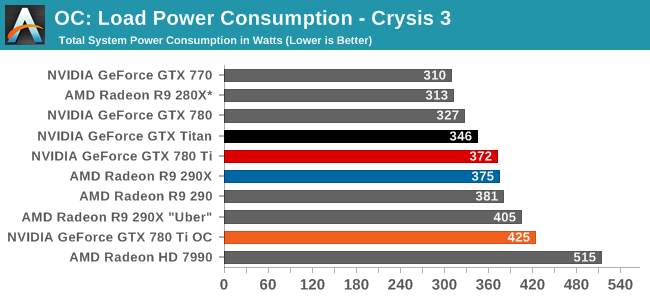
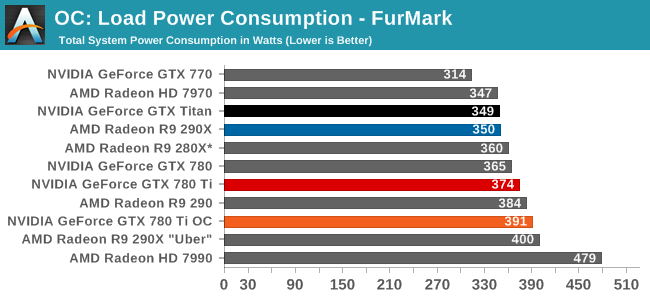
Starting as always with power, temperatures, and noise, we can see that overclocking GTX 780 Ti further increases its power consumption, and to roughly the same degree as what we’ve seen with GTX 780 and GTX Titan in the past. With a maximum TDP of just 106% (265W) the change isn’t so much that the card’s power limit has been significantly lifted – as indicated by FurMark – but rather raising the temperature limit virtually eliminates temperature throttling and as such allows the card to more frequently stay at its highest, most power hungry boost bins.
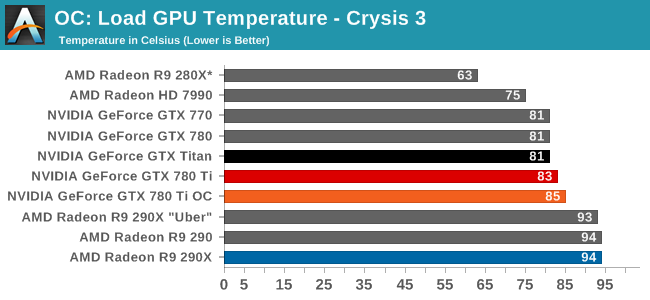

Despite the 95C temperature target we use for overclocking, the GTX 780 Ti finds its new equilibrium point at 85C. The fan will ramp up long before it allows us to get into the 90s.
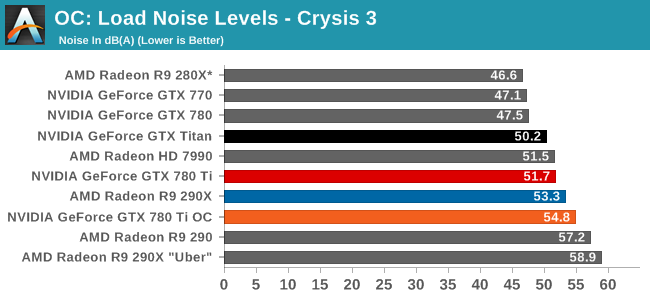
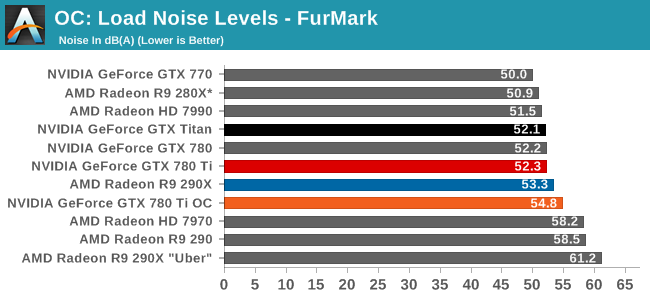
Given the power jump we saw with Crysis 3 the noise ramp up is surprisingly decent. A 3dB rise in noise is going to be noticeable, but even in these overclocked conditions it will avoid being an ear splitting change. To that end overclocking means we’re getting off of GK110’s standard noise efficiency curve just as it does for power, so the cost will almost always outpace the payoff on a relative basis.
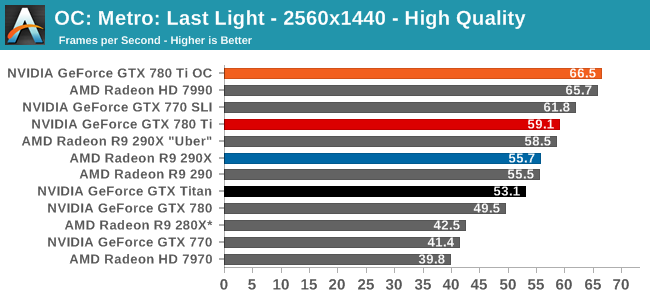
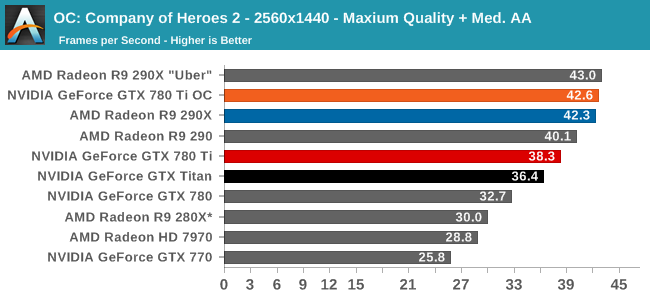
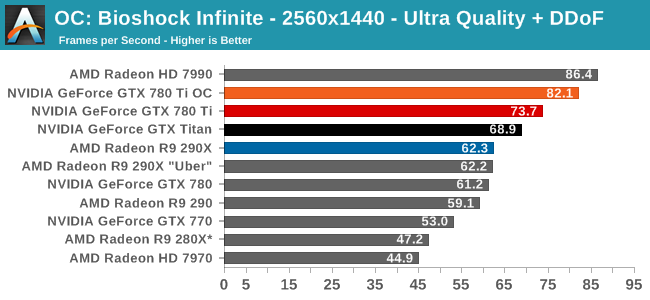
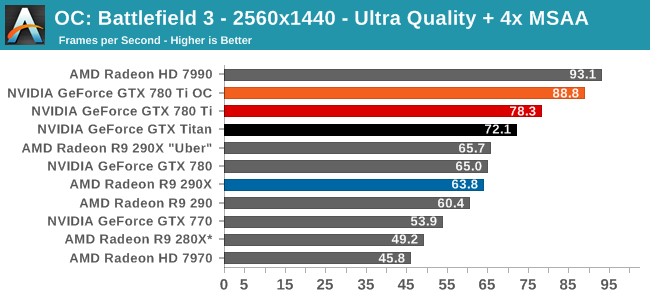
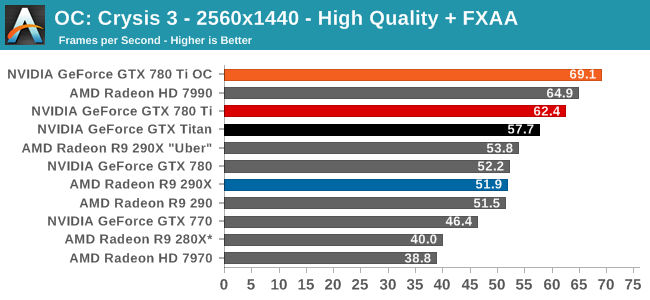
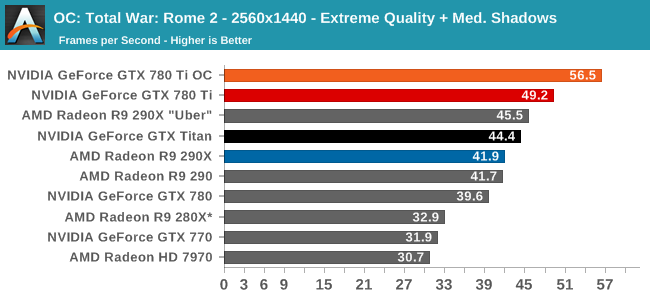
Finally, looking at gaming performance the the overall performance gains for overclocking are generally consistent. Between our 6 games we see a 10-14% performance increase, all in excess of the memory overclock and closely tracking the GPU overclock. GTX 780 Ti is already the fastest single-GPU card, so this only further improves its performance lead. But it does so while cutting into whatever is above it, be it the games where the stock 290X has a lead, or multi-GPU setups such as the 7990.










302 Comments
View All Comments
r13j13r13 - Friday, November 8, 2013 - link
a los fans de NVIDIA no se preocupen pronto sacaran la version de 1000 dolares con un 5% mas de rendimientotwtech - Friday, November 8, 2013 - link
An interesting comparison would be a 780 Ti vs. crossfired 290s. In the previous generation of cards, I wouldn't have considered that fair, as any type of SLI/crossfire setup was definitely inferior to any single-card setup in a variety of ways. But that's changed in this latest generation.I bought two 290X on launch day (I knew they would go out of stock by day 3, and not come back into general availability for something like 2 months), but the experience compared to the last time I'd tried CF a few years back was completely different. There are no bridges to worry about - you just plug in the two cards and go. CF doesn't have any sync polarity issues, and the driver support for CF & multi-monitor is actually pretty fleshed out. I didn't notice any stuttering or texture corruption as I had the previous time I'd given CF a try.
In fact the only reason I tried it now is because I have 3 2560x1600 monitors, and driving that is too much to ask out of a single card. The two 290X handle it easily though.
FuriousPop - Sunday, November 10, 2013 - link
what frames are you getting?i currently have 2x7970's in CF and was looking to upgrade to handle my same setup.
DMCalloway - Friday, November 8, 2013 - link
Wow !!! There sure are a lot of used 780's on Eb*y......meanwhile in a very luxurious board room in Santa Clara California ..... ' but sir.... do you really think they'll sell at that price point? '.....( while laughing ) ' of course they'll sell at that price point; our consumer research polls show that our customer base simply can't help themselves.'..... and throughout the world the rustling of wallets and swishing of credit cards could be heard as green team loyalist geared up to purchase their second almost $700 gtx 780 for 2013...... : )polaco - Friday, November 8, 2013 - link
This is what we are talking about:http://www.tomshardware.com/reviews/radeon-r9-290-...
when 290's get theirs non reference coolers NVidia 780 Ti will have to take it's bargains and go home definitley. AMD's 290 ans 290X series are full of hopes to hit even better performance numbers, however NVidia's 780Ti are at it's max.
EJS1980 - Friday, November 8, 2013 - link
" AMD's 290 ans 290X series are full of hopes to hit even better performance numbers, however NVidia's 780Ti are at it's max..."OC'ing the 780ti will give you around 15-20% more performance, or higher, so what the hell are you talking about? I realize you're in love with all things AMD, but if you can take your goggles off for a second, you'd realize the 780ti is actually a really great card (much like the 290(x), obviously).
I had NO IDEA how many AMD fanboys could be found mouth-breathing on the internet, at any given time. Which begs the question: if AMD has so many fanboys, why the f*ck are they doing so poorly in the discrete GPU market?
polaco - Saturday, November 9, 2013 - link
Yes I do prefer AMD due to it's fair price. However what I'm talking about is that with non reference cooler 290-290X will be able to run pretty cool and have decent overclocking potential too, as shown in tomshardware chart. Since they cost several bucks less than NVidia cards and at that point should be a pretty closed gap in performance (in fact they already are) then AMD cards will be at an extremely nice price/performance point. What do you mean by poorly in discrete GPU? Many APUs has been sold, APUs are replacing discrete GPUs, all PS4 and XBox One are like discrete GPUs. And I do have preference by AMD but mainly coz this reasons: they have always been trying to innovate, they have to compete with a giant as Intel and they bring price balance to the GPU / CPU market. That doen't mean I will buy them whatever they take to the market, I evaluate all options and buy what fits my needs better. In fact 780ti is a great card nobody says the opposite, just quite expensive from my point of view and I don't want to get into the "how much NVidia has been abusing buyers wallet during this months". I wonder if any NVidia fan that has acquired and 780 or Titan previouly to 290 entry to the market could recognize that...Owls - Saturday, November 9, 2013 - link
OCing a Ti is not guaranteed. Why do people parrot this info around like every card is going to peform the way you describe?EJS1980 - Saturday, November 9, 2013 - link
Again, what the hell are you people talking about???Even though results can very from card to card, EVERY 780ti can be overclocked to boost performance by a significant margin. These chips are the cream of the Kepler crop, and Nvidia is confident enough with their yields that a substantial OC is all but guaranteed with each card, as EVERY review so far has illustrated.
I personally feel this card is about a $100 overpriced, and as such, I will NOT be upgrading at this time. I also believe that even with the significant problems inherent to the new Hawaii chips, they are powerful cards at an EXCELLENT price point.
However, I'm not going to pretend that the 290(x) are faster than the 780ti, just because their priced better. So many of you guys keep pointing out that once after market solutions arrive, the 290(x) will take back the crown, and that simply isn't true. Performance will obviously improve, but only to levels comparable to a STOCK 780ti, and maybe not even that. That's where OC'ing comes in to play, for if we're going to compare the 290(x) OC'd with a better cooling solution, then the same must be applied to the 780ti too. I expect the 780ti to maintain its 5-15% performance advantage over the 290(x) after they've BOTH released their aftermarket solutions, so the question ultimately returns to whether or not the consumer finds that performance advantage to be worthy of the price differential. Just because you don't, or I don't, does NOT mean that anyone else won't too, or that there isn't even a advantage to begin with, which there undoubtedly will be...
Mondozai - Friday, December 13, 2013 - link
EJS1980, the mouth-breathing Nvidia fanboy, you're talking about a card(GTX 780 Ti) which with an aftermarket cooler could have an advantage as low as 5% for 200-250 dollars more in price. Only a Nvidia buttboy would think that's a good deal, you've been raped by them through their pricing for so long, you've come to even enjoy it.Most sane, non-buttboys will opt for the best price/performance ratio. Including for high-end cards. A 290 in CF with aftermarket coolers will crush everything. Even a 290X on an aftermarket cooler is going to do a lot better, especially as we transition to 4K within the next 1-2 years.
Stop being a buttboy for Nvidia.
(P.S. I'm currently using an Nvidia card, but I always get embarrassed when I see buttboys for a specific company like yourself).